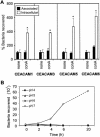Engulfment of Neisseria gonorrhoeae: revealing distinct processes of bacterial entry by individual carcinoembryonic antigen-related cellular adhesion molecule family receptors
- PMID: 15102784
- PMCID: PMC387857
- DOI: 10.1128/IAI.72.5.2742-2752.2004
Engulfment of Neisseria gonorrhoeae: revealing distinct processes of bacterial entry by individual carcinoembryonic antigen-related cellular adhesion molecule family receptors
Abstract
Individual Neisseria gonorrhoeae colony opacity-associated (Opa) protein variants can bind up to four different carcinoembryonic antigen-related cellular adhesion molecule (CEACAM) receptors. Most human cells encountered by gonococci express a combination of CEACAM receptors, thereby complicating the elucidation of intracellular signaling pathways triggered by individual receptors. Here, we compare the process of bacterial engulfment by a panel of stably transfected HeLa epithelial cell lines expressing each CEACAM receptor in isolation. CEACAM1 and CEACAM3 each contain proteinaceous transmembrane and cytoplasmic domains; however, the processes of neisserial uptake mediated by these receptors differ with respect to their susceptibilities to both tyrosine kinase inhibitors and the actin microfilament-disrupting agent cytochalasin D. Neisserial uptake mediated by glycosylphosphatidylinositol (GPI)-anchored CEACAM5 and CEACAM6 was not significantly affected by any of a broad spectrum of inhibitors tested. However, cleavage of the GPI anchor by phosphatidylinositol-specific phospholipase C reduced bacterial uptake by HeLa cells expressing CEACAM5, consistent with a single zipper-like mechanism of uptake mediated by this receptor. Regardless of the CEACAM receptor expressed, internalized gonococci were effectively killed by a microtubule-dependent process that required acidification of the bacterium-containing phagosome. Given the phase-variable nature of neisserial Opa proteins, these results indicate that the mechanism of bacterial engulfment and the cellular response to gonococcal infection depend on both the receptor specificities of the neisserial Opa protein variants expressed and the spectrum of CEACAM receptors present on target cells, each of which determines the combination of receptors ultimately engaged.
Figures








Similar articles
-
Specific Binding to Differentially Expressed Human Carcinoembryonic Antigen-Related Cell Adhesion Molecules Determines the Outcome of Neisseria gonorrhoeae Infections along the Female Reproductive Tract.Infect Immun. 2018 Jul 23;86(8):e00092-18. doi: 10.1128/IAI.00092-18. Print 2018 Aug. Infect Immun. 2018. PMID: 29760215 Free PMC article.
-
Innate recognition by neutrophil granulocytes differs between Neisseria gonorrhoeae strains causing local or disseminating infections.Infect Immun. 2013 Jul;81(7):2358-70. doi: 10.1128/IAI.00128-13. Epub 2013 Apr 29. Infect Immun. 2013. PMID: 23630956 Free PMC article.
-
Pathogenic Neisseria trigger expression of their carcinoembryonic antigen-related cellular adhesion molecule 1 (CEACAM1; previously CD66a) receptor on primary endothelial cells by activating the immediate early response transcription factor, nuclear factor-kappaB.J Biol Chem. 2001 Jun 29;276(26):24331-40. doi: 10.1074/jbc.M006883200. Epub 2001 Apr 16. J Biol Chem. 2001. PMID: 11306560
-
The role of neisserial Opa proteins in interactions with host cells.Trends Microbiol. 1998 Dec;6(12):489-95. doi: 10.1016/s0966-842x(98)01365-1. Trends Microbiol. 1998. PMID: 10036728 Review.
-
Opa proteins and CEACAMs: pathways of immune engagement for pathogenic Neisseria.FEMS Microbiol Rev. 2011 May;35(3):498-514. doi: 10.1111/j.1574-6976.2010.00260.x. Epub 2011 Jan 17. FEMS Microbiol Rev. 2011. PMID: 21204865 Review.
Cited by
-
Neisseria gonorrhoeae suppresses dendritic cell-induced, antigen-dependent CD4 T cell proliferation.PLoS One. 2012;7(7):e41260. doi: 10.1371/journal.pone.0041260. Epub 2012 Jul 23. PLoS One. 2012. PMID: 22844448 Free PMC article.
-
Progress Toward a Gonococcal Vaccine: The Way Forward.Front Immunol. 2019 Oct 15;10:2417. doi: 10.3389/fimmu.2019.02417. eCollection 2019. Front Immunol. 2019. PMID: 31681305 Free PMC article. Review.
-
The adaptor molecule Nck localizes the WAVE complex to promote actin polymerization during CEACAM3-mediated phagocytosis of bacteria.PLoS One. 2012;7(3):e32808. doi: 10.1371/journal.pone.0032808. Epub 2012 Mar 20. PLoS One. 2012. PMID: 22448228 Free PMC article.
-
The Pathobiology of Neisseria gonorrhoeae Lower Female Genital Tract Infection.Front Microbiol. 2011 May 10;2:102. doi: 10.3389/fmicb.2011.00102. eCollection 2011. Front Microbiol. 2011. PMID: 21747805 Free PMC article.
-
Phosphatidylinositol 3'-kinase activity is critical for initiating the oxidative burst and bacterial destruction during CEACAM3-mediated phagocytosis.J Biol Chem. 2011 Mar 18;286(11):9555-66. doi: 10.1074/jbc.M110.216085. Epub 2011 Jan 7. J Biol Chem. 2011. PMID: 21216968 Free PMC article.
References
-
- Beauchemin, N., P. Draber, G. Dveksler, P. Gold, S. Gray-Owen, F. Grunert, S. Hammarstrom, K. V. Holmes, A. Karlsson, M. Kuroki, S.-H. Lin, L. Lucka, S. M. Najjar, M. Neumaier, B. Obrink, J. E. Shively, K. M. Skubitz, C. P. Stanners, P. Thomas, J. A. Thompson, M. Virji, S. von Kleist, C. Wagener, S. Watt, and W. Zimmermann. 1999. Redefined nomenclature for members of the carcinoembryonic antigen family. Exp. Cell Res. 252:243-249. - PubMed
-
- Berling, B., F. Kolbinger, F. Grunert, J. A. Thompson, F. Brombacher, F. Buchegger, S. von Kleist, and W. Zimmermann. 1990. Cloning of a carcinoembryonic antigen gene family member expressed in leukocyte of chronic myeoid leukemia patients and bone marrow. Cancer Res. 50:6534-6539. - PubMed
-
- Billker, O., A. Popp, S. D. Gray-Owen, and T. F. Meyer. 2000. The structural basis of CEACAM-receptor targeting by neisserial Opa proteins. Trends Microbiol. 8:258-260. - PubMed
-
- Booth, J. W., D. Telio, E. H. Liao, S. E. McCaw, T. Matsuo, S. Grinstein, and S. D. Gray-Owen. 2003. Phosphatidylinositol 3-kinases in CEACAM-mediated internalization of Neisseria gonorrhoeae. J. Biol. Chem. 278:14037-14045. - PubMed
Publication types
MeSH terms
Substances
LinkOut - more resources
Full Text Sources
Miscellaneous

